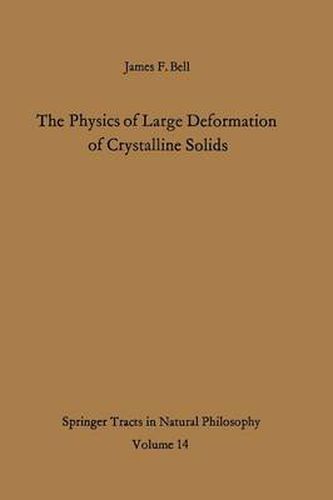Readings Newsletter
Become a Readings Member to make your shopping experience even easier.
Sign in or sign up for free!
You’re not far away from qualifying for FREE standard shipping within Australia
You’ve qualified for FREE standard shipping within Australia
The cart is loading…






This title is printed to order. This book may have been self-published. If so, we cannot guarantee the quality of the content. In the main most books will have gone through the editing process however some may not. We therefore suggest that you be aware of this before ordering this book. If in doubt check either the author or publisher’s details as we are unable to accept any returns unless they are faulty. Please contact us if you have any questions.
Historically, a major problem for the study of the large deformation of crystalline solids has been the apparent lack of unity in experimentally determined stress-strain functions. The writer’s discovery in 1949 of the unexpectedly high velocity of incremental loading waves in pre-stressed large deformation fields emphasized to him the pressing need for the independent, systematic experimental study of the subject, to provide a firm foundation upon which physically plausible theories for the finite deformation of crystalline solids could be constructed. Such a study undertaken by the writer at that time and continued uninterruptedly to the present, led in 1956 to the development of the diffraction grating experiment which permitted, for the first time, the optically accurate determination of the strain-time detail of non-linear finite amplitude wave fronts propagating into crystalline solids whose prior history was precisely known. These experimental diffraction grating studies during the past decade have led to the discovery that the uniaxial stress-strain functions of 27 crystalline solids are unified in a single, generalized stress-strain function which is described, much of it hitherto unpublished, in the present monograph. The detailed study of over 2,000 polycrystal and single crystal uni axial stress experiments in 27 crystalline solids, in terms of the variation of a large number of pertinent parameters, has provided new unified pat terns of understanding which, it is hoped, will be of interest and value to theorists and experimentalists alike.
$9.00 standard shipping within Australia
FREE standard shipping within Australia for orders over $100.00
Express & International shipping calculated at checkout
This title is printed to order. This book may have been self-published. If so, we cannot guarantee the quality of the content. In the main most books will have gone through the editing process however some may not. We therefore suggest that you be aware of this before ordering this book. If in doubt check either the author or publisher’s details as we are unable to accept any returns unless they are faulty. Please contact us if you have any questions.
Historically, a major problem for the study of the large deformation of crystalline solids has been the apparent lack of unity in experimentally determined stress-strain functions. The writer’s discovery in 1949 of the unexpectedly high velocity of incremental loading waves in pre-stressed large deformation fields emphasized to him the pressing need for the independent, systematic experimental study of the subject, to provide a firm foundation upon which physically plausible theories for the finite deformation of crystalline solids could be constructed. Such a study undertaken by the writer at that time and continued uninterruptedly to the present, led in 1956 to the development of the diffraction grating experiment which permitted, for the first time, the optically accurate determination of the strain-time detail of non-linear finite amplitude wave fronts propagating into crystalline solids whose prior history was precisely known. These experimental diffraction grating studies during the past decade have led to the discovery that the uniaxial stress-strain functions of 27 crystalline solids are unified in a single, generalized stress-strain function which is described, much of it hitherto unpublished, in the present monograph. The detailed study of over 2,000 polycrystal and single crystal uni axial stress experiments in 27 crystalline solids, in terms of the variation of a large number of pertinent parameters, has provided new unified pat terns of understanding which, it is hoped, will be of interest and value to theorists and experimentalists alike.